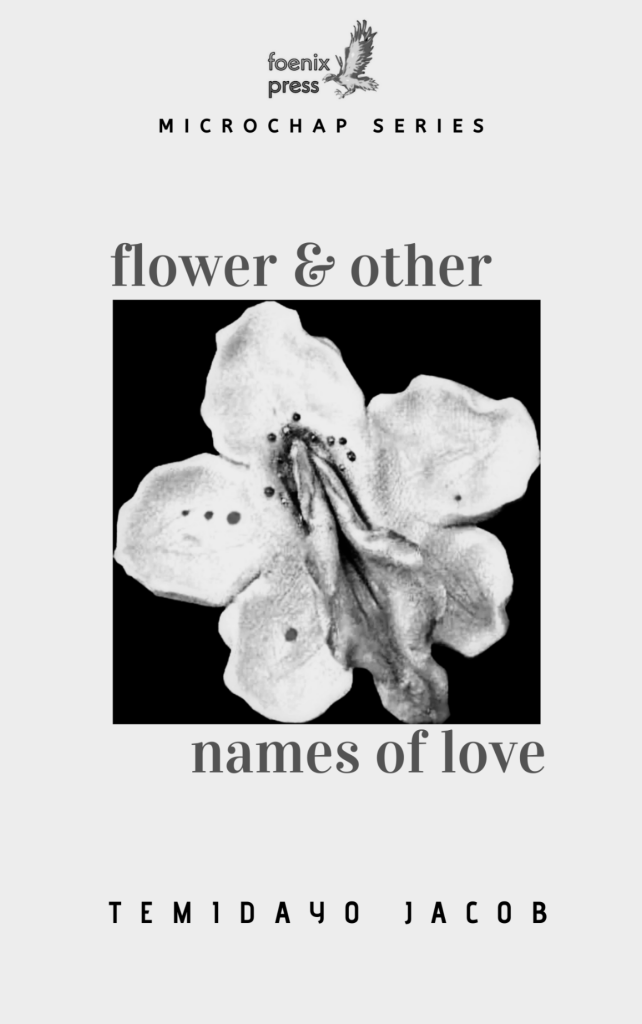Review by: Ola Halim
Book Genre: Poetry
Author: Temidayo Jacob

AS a child growing up at Green Egbedi, a then semi-rural area in Sapele, Delta State, nature sprawled the stunted lengths my eyes could go. There were birds on the dense trees surrounding the rented bungalows. Sometimes, during rainy season, some of them built nests in the corridor, high up against the fuse, and we let them be, because Mama said they were God’s birds, and any child who bothered God’s birds would wet their bed to adulthood. There were a bunch of variants, these birds. Large birds with sickle-shaped beaks the colour of carrots. Thin, tall birds with tennis-ball eyes. Circular birds with short, reddish legs and naturally clipped wings and cones of dangling flesh at their necks. Bedraggled little birds with velvet-soft feathers which my cousins and I snatched from their nests up the trees and put them in raffia cages under Baba’s bed. There were also trees and bushes and flowers almost forming semicircles around our bungalows. There were caramel petals on thick, jade bushes spanning the wall opposite. There were a carpet of yellow around these bushes, and whenever it rained, you could scoop what we called golden sand—yellow and slimy—and heat it on fire and make sandcakes with them. But I didn’t love anything natural like I did the violet petals on my way to school. I’d stop on the way, pluck a petal, breathe in its fragrance, run tentative fingers over its maroon stigmas, peer in to discover a certain circle of carmine nestled inside. I didn’t know specific names of birds or flowers as a child. But I knew this: birds were beautiful; trees were beautiful; and flowers were beautiful. So, at adolescence, on a Valentine, I gave my first crush a flower, a red hibiscus bud shaped like a miniature gherkin. I wanted to tell her without words that she was beautiful. Just like flowers. And I loved her (although love was, and is still, an ambiguity for me). Just like I loved flowers. Eleven years later, I still remember her response: Oh, red is my favourite colour! That slow, adenoodal voice—Oh, red is my favourite colour!—reverberated when TEMIDAYO JACOB sent me this poetry collection. Why? The title is in maroon, a deep, gushing red; and the cover image depicts a flower with specks of red. Oh, red is my favourite colour!
Jacob drives me back to Sapele in this collection. Once again, my past, a resplendent bouquet, a flight of birds, their bellies ashen against the cinammon of their bodies, all spread out before me. He picks up a knife and, with the fitting metaphor of flowers, dissects the organism called love. He divides it into its independent yet often crisscrossing properties: desire, ecstacy, loss, loneliness, sex, belonging, admiration, and the clustered infinite. “Rose”, the first poem in this collection, mourns the physical loss of love—physical because as the persona “burn(s) one petal each night,” he remembers the warmth of his lover. Love is hinted as being a survivor, the ash that endures after apocalypse, after Earth and her offspring are a deserted flatland, the horizon seething afar, naked, a xanthous strip. The persona recognises this ash of love by “its unyielding fire” and “become(s) intoxicated with (your) absence.”
The orchid is a distinctively-shaped flower of bright violet-red. The poet drives the features of this stunning flowers into the second poem, “Orchid”. At the end, it intermeshes into the metaphor for twists and turns on the pavement of love. It examines love and fanatism sprouting on the same garden: one, weed; the other, crop. But because the persona, like every other misguided person, “do(es) not ask for understanding” nor wisdom to recognise weed posing as crops, he cannot differentiate between both. He cannot tell if love is weed, not with its smell nor shape of its leaves. He cannot tell if bigotry is a crop. What then happens when love, the supposed harbinger of light, is reduced to silhouettes to keep truth and humanity at bay, to perpetuate dogma, redtapism, stifling bureaucracy, stuffiness?
“Poppy” just pops out before you: the slender chartreuse stem holding stalks of rumpled petals a blinding red—Oh, red is my favourite colour!—blotches of orange against an overhung bush. Just as this flower is a head-turner, pulling second glances with a thump, the persona in “Poppy” is addicted to his lover. She draws him, pulls him, drives him with her fragrance: the picture of a dog skidding down a path, nostril to the loam, tracing a scent, comes to mind here. Here, we are drawn into an enslavement—a whiff of intoxicating breath, a nostril-tingling scent, a titillating touch, a mental panorama without bounds—and, just like the persona, we bask in this enslavement because it is exotic, scrubbed-to-shimmer new; because this enslavement feels like liberty, reminds us so much of liberty. With the sublime imagery of pollination, “Clitoria” explores lust and its crescendo, sex. “Mustard” peers through lovelorn with new lens, embossing dots on an otherwise velvety skin. Here, the persona questions the basis of attraction (and the blurred cusps of whatever initiates love) with two seeming contradictions: no one appreciates the beauty of my petals; …before I begin to get beautiful. The longing for companionship is a quagmire. You toggle between self-satisfaction or something close (as defence mechanism for dark instances your mind conjures) and self-criticism. Or why else would a petal already beautiful want to die (“fade & either”) “before i(t) begin(s) to get beautiful”? The collection wraps up with “Cyclamen”, a combination of soft-as-cotton-fuzz romance and throbbing-as-hurrying-feet coitus. This thematic transformation captures the abrupt changes in emotions as fiery-famished sexual urges begin to invade romance.
It is a pleasure to read these poems—six in all. They twist my memories into wildly-imagined, far-flung facts, and fiction posing as real. I doubt all I remember, and I want to believe all I can’t remember. They are simple, short, storylike, dotted with familiar images and interestingly break the rules of punctuation. This is another masterpiece after the first, the well illustrated (both in words and pictures) Beauty of Ashes, that will stay with me for a while. I seldom forget beautiful memories. And beautiful memories are memories that wake up feelings I’d thought long dead in me again. And reading this collection is a beautiful memory. I’m a child again, growing up at Green Egbedi, Sapele, rubbing shoulders with nature; blooming into adolescence, watching, transfixed, as my crush says, “Oh, red is my favourite colour!”
— Ola W. Halim, Writer.
